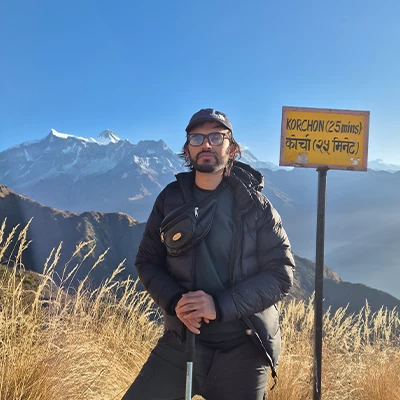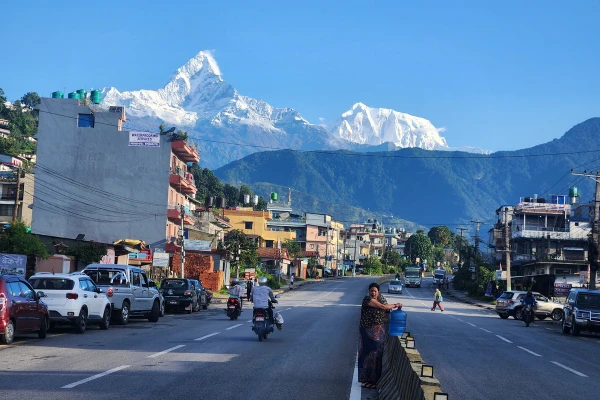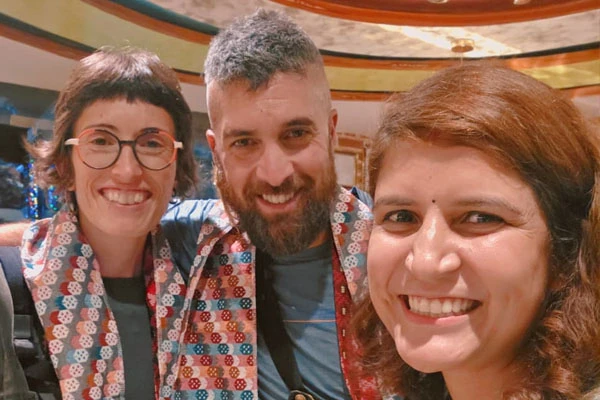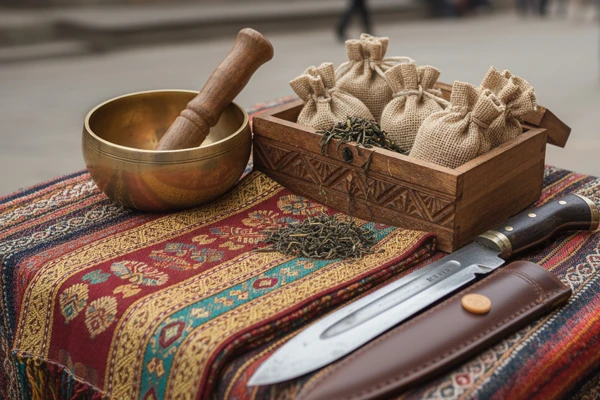Why is Tihar called the Festival of Lights in Nepal?
As night falls over Nepal during Tihar, the country transforms into a golden dreamscape. Streets shimmer with countless oil lamps (diyos), homes glow with strings of marigolds and electric lights, and temple courtyards flicker with devotional flames. This breathtaking spectacle is why Tihar is famously known as the "Festival of Lights". But the meaning runs deeper than just beauty.
The Triumph of Light Over Darkness
Tihar symbolizes the victory of light over darkness, knowledge over ignorance, and hope over despair. Lighting lamps is an ancient Hindu tradition that invites prosperity and wards off negativity. Each tiny diyo represents a prayer for blessings, echoing legends where light defeated evil (like Lord Ram’s return to Ayodhya or the goddess Laxmi’s love for illumination).
Welcoming Laxmi, the Goddess of Wealth
The third day of Tihar is called Laxmi Puja, and this day is dedicated to the goddess of wealth and fortune. Families clean their homes, create intricate rangoli (colorful floor art), and light rows of lamps to guide Laxmi inside. It is believed she only visits the brightest, most welcoming homes; so Nepal lights up to summon her blessings!
A Cosmic Thank-You to Nature
Tihar’s lights also honor nature’s gifts. The festival falls after harvest season, so the glowing lamps express gratitude to the sun, earth, and animals that sustain life. From crows to cows, every honored creature is part of this luminous cycle of gratitude.
A Unifying Celebration
Beyond religion, the lights create magic for everyone. In Kathmandu, tourist hubs like Thamel dazzle with fairy lights, while villages host bonfires and candlelit feasts. The warm, golden glow turns strangers into friends, whether you are singing Deusi-Bhailo with locals or sharing sweets with neighbors.
History of Tihar Festival in Nepal
Tihar is also Nepal’s second-largest festival after Dashain, and people celebrate dazzlingly with lights, nature worship, and sibling bonds. But where did this luminous tradition begin? Its roots weave through ancient Hindu scriptures, harvest rituals, and even pre-Vedic animist traditions, making it a fascinating blend of history and spirituality.
Origins in Hindu Tradition
Tihar is also called Deepawali or Yamapanchak, and the festival stretches back thousands of years into the Vedic era. Ancient Hindu scriptures emphasize honoring not just gods and goddesses but also the natural world, animals, and cosmic forces that sustain life. The festival is intimately tied to the worship of Yama, the god of death, and Lakshmi, the goddess of wealth and prosperity.
The term Yamapanchak means “five days of Yama,” reflecting the festival’s five-day sequence of worship and rituals. In its earliest form, Tihar was closely linked to Nepal’s agrarian lifestyle, where farmers and villagers acknowledged the indispensable roles of animals. Those animals include crows, dogs, cows, and oxen in agriculture and community protection. Lighting oil lamps was both a spiritual act to invite divine blessings and a practical symbol of warding off evil forces during the darkest nights of the lunar month.
Mythological Legends Behind Tihar
The most famous legend explaining Tihar’s origin is from the Skanda Purana and Garuda Purana. According to the story, Yamuna, the devoted sister of Yama, the god of death, invited her brother to visit her home. She greeted him warmly with a garland (mala), a multi-colored tika on his forehead, and a lavish meal, praying for his protection from untimely death and misfortune. Touched by her devotion, Yama blessed her and declared that any brother who received a tika from his sister on this day would enjoy a long, prosperous, and healthy life. This tradition became the foundation for Bhai Tika, the grand finale of the Tihar festival in Nepal.
Another legend connects Tihar to the story of King Mahabali and the worship of Goddess Lakshmi. Just as in Indian Diwali traditions, this tale symbolizes the triumph of light over darkness and good over evil. However, in Nepal, this legend is interwoven with animal worship and community celebrations. This makes Tihar a uniquely blended festival that honors divine forces, kinship, and the natural world all at once.
How is Tihar Celebrated in Nepal?
Tihar stands apart from other South Asian festivals because it blends Hindu mythology, Nepali agrarian traditions, and deeply personal family rituals into a single celebration. While the Indian Diwali largely centers on Lakshmi Puja and the return of Lord Rama from exile, Tihar in Nepal incorporates a wider set of cultural elements. The worship of animals is not symbolic alone, as it reflects a genuine respect for the creatures that have historically sustained rural life. Crows are honored as messengers, dogs as loyal guardians, cows as symbols of wealth and milk providers, and oxen as agricultural partners. Beyond animal worship, the Bhai Tika ritual adds an emotional depth unique to Nepal, celebrating the sacred bond between brothers and sisters.
Another distinct feature is the Deusi-Bhailo tradition, where groups of young people, children, and sometimes even entire community teams go door to door singing blessings, dancing, and receiving small gifts, sweets, or money. Historically, this practice likely began as a form of communal fundraising for temples, village projects, or festivals. Over centuries, it evolved into a lively and inclusive part of Tihar that strengthens community bonds. The combination of spiritual devotion, nature reverence, sibling love, and vibrant social activities makes Tihar not just a religious festival but also a celebration of Nepal’s identity, resilience, and togetherness.
The Five Days of Tihar: A Day-by-Day Celebration
Day 1: Kaag Tihar (Crow Tihar)
The festival begins with Kaag Tihar, a day dedicated to crows. The crow is revered as the messenger of Yama, who is the Hindu god of death. In Hindu belief, crows are considered carriers of important news from the spiritual realm, and their cawing is thought to forewarn or remind people of the need for awareness and protection. On this day, households prepare offerings such as cooked rice, grains, and sweet treats early in the morning and place them on rooftops, walls, or open yards.
The ritual symbolizes an offering to keep off misfortune and invite good fortune into the household. The sound of crows partaking in the food is seen as a sign that the offering has been accepted, blessing the family with protection from evil omens. This day sets the spiritual tone for Tihar, reminding people to respect even the smallest creatures in the natural cycle.
Day 2: Kukur Tihar (Dog Tihar)
The second day of Tihar shifts the focus to dogs, celebrated for their unwavering loyalty, companionship, and protective nature. In Nepalese tradition, dogs are not only valued as human companions but are also believed to be the guardians of the afterlife, guiding souls safely after death. People adorn their dogs, whether pets, strays, or working dogs, with colorful flower garlands (mala).
They apply a red vermilion tika to their foreheads and offer them delicious meals, meat, biscuits, and other special treats. The garland symbolizes dignity and honor, while the tika is a blessing for well-being. This day reinforces the deep bond between humans and dogs, celebrating them as protectors in both the physical and spiritual realms. Even street dogs receive love and offerings on this day, highlighting Tihar’s inclusive spirit.
Day 3: Gai Tihar and Lakshmi Puja (Cow Worship and Worship of Goddess Laxmi)
The third day of Tihar is one of the most elaborate, combining the worship of cows during the day and the grand celebration of Lakshmi Puja in the evening. In Hindu culture, the cow is considered a sacred embodiment of wealth, nourishment, and motherhood. It is revered as a source of dairy, agricultural aid, and even dung, which has traditional uses in fuel and purification rituals. On Gai Tihar, cows are decorated with flower garlands, their horns and bodies sometimes painted with natural colors, and they are offered special feed in gratitude for their role in human sustenance.
As night falls, households prepare for Lakshmi Puja, dedicated to the goddess of wealth, fortune, and prosperity. Homes are cleaned thoroughly and adorned with colorful rangoli patterns and rows of oil lamps (diyas) to welcome Goddess Lakshmi into the household. The flickering lights symbolize the removal of darkness and ignorance, inviting abundance and positivity. Offerings of sweets, fruits, and prayers are made, and families perform rituals to seek her blessings for the year ahead. Streets come alive with music, singing, and firecrackers. Children go from house to house singing Deusi-Bhailo songs in exchange for treats or coins, adding a lively communal spirit to the day.
Day 4: Goru Tihar and Govardhan Puja
On the fourth day, the spotlight turns to oxen (goru), which play a vital role in Nepal’s agricultural economy. Oxen have traditionally been indispensable for plowing fields and transporting goods in rural life because they are known for their strength and endurance. Farmers show their gratitude by decorating the oxen with garlands, applying tika, and feeding them special meals. This act honors their hard work and acknowledges their contribution to the sustenance of human communities.
This day also coincides with Govardhan Puja, a ritual rooted in the legend of Lord Krishna lifting the Govardhan Hill to protect the people of Vrindavan from torrential rains sent by Lord Indra. In Nepal, people create symbolic replicas of the hill using cow dung, shaped into small mounds, and decorate them with flowers and food offerings. The ritual reflects gratitude towards nature for providing shelter and sustenance, as well as the belief that divine protection is always present when faith is strong.
Day 5: Bhai Tika
The final and perhaps the most emotionally significant day of Tihar is Bhai Tika, a celebration of the sacred bond between brothers and sisters. On this day, sisters perform a ceremonial puja for their brothers’ long life, health, and prosperity. They apply a unique seven-colored tika to their brothers’ foreheads, symbolizing protection from harm, and adorn them with garlands made of marigolds. A lavish feast is prepared, and in return, brothers present gifts, money, or clothing to their sisters while pledging their protection and care. The ritual is deeply symbolic, as it reflects mutual respect, familial love, and the promise of lifelong support between siblings. Even those without biological siblings often celebrate Bhai Tika with close friends or cousins, showing the festival’s inclusive and heartfelt nature.
Tihar 2025 Nepali Calendar Dates
Day | Festival/Event | Date (AD, 2025) | Date (BS, 2082) |
Day 1 | Kaag Tihar (Crow Tihar) | October 19, 2025 (Sunday) | Kartik 2, 2082 |
Day 2 | Kukur Tihar (Dog Tihar) | October 20, 2025 (Monday) | Kartik 3, 2082 |
Day 3 | Gai Tihar & Laxmi Puja (Cow & Lakshmi) | October 21, 2025 (Tuesday) | Kartik 4, 2082 |
Day 4 | Goru Tihar / Govardhan Puja / Mha Puja | October 22, 2025 (Wednesday) | Kartik 5, 2082 |
Day 5 | Bhai Tika | October 23, 2025 (Thursday) | Kartik 6, 2082 |
Food & Sweets of Tihar
No celebration in Nepal is complete without an abundance of delicious food, and Tihar is a culinary paradise! From crispy fried bread to syrup-soaked treats, the festival’s sweets and dishes are as much a part of the tradition as the diyo lamps and Bhai Tika. Here is your guide to the must-try foods of Tihar, each with its cultural significance.
Sel Roti (Ring-Shaped Bread)
What it is: A homemade, ring-shaped deep-fried bread made from rice flour batter.
Sel Roti is made from a batter of rice flour, sugar, ghee, and cardamom, mixed into a thick, pourable consistency. The key is fermenting the batter for 4–6 hours, allowing it to develop a slight tanginess. To cook, a ring-shaped mold or a steady hand is used to pour the batter into hot oil, where it sizzles until golden-brown. The trick lies in maintaining medium heat—too hot, and the outside burns before the inside cooks; too low, and the Sel Roti absorbs excess oil. Once fried, it is drained on paper and served warm or stored in airtight containers for days. The best Sel Roti has a crisp exterior and a soft, slightly chewy center with a texture perfected over generations.
Anarsha (Crispy Deep Fried Sweet Bread)
What it is: A sweet, disc-shaped pastry made from rice flour, jaggery, and sesame seeds.
Anarsa starts with soaked rice (often kept overnight), which is ground into a paste and mixed with jaggery or sugar for sweetness. The dough is shaped into small discs, then coated with white sesame seeds for a nutty crunch. Unlike Sel Roti, Anarsa is shallow-fried in ghee on a low flame, allowing the jaggery to caramelize slowly without burning. The result is a crisp, aromatic sweet with a deep molasses-like flavor. Some recipes call for a splash of milk or coconut to soften the texture, but traditionalists swear by the pure rice-jaggery-sesame combo.
Laddu
What it is: Round, bite-sized sweets made from flour, ghee, sugar, and nuts.
Laddu comes in many forms, but the besan (gram flour) version is a Tihar favorite. Gram flour is dry-roasted in ghee until fragrant, then combined with sugar syrup, cardamom, and chopped nuts. The mixture is kneaded while warm and rolled into bite-sized spheres before setting. Another popular version, boondi laddu, involves frying tiny gram flour droplets, soaking them in syrup, and shaping them into balls. The key to perfect laddu is the sugar syrup’s consistency, which should form a soft thread when pressed between fingers. Too sticky, and the laddu hardens; too thin, and it crumbles.
Kheer (Rice Pudding)
What it is: A rich, slow-cooked dessert made from rice, milk, sugar, and cardamom, sometimes garnished with nuts and raisins.
Authentic Nepali kheer is slow-cooked for hours. Basmati rice is simmered in full-fat milk with sugar, cardamom, and sometimes saffron, stirring constantly to prevent sticking. As the rice breaks down, the milk reduces into a luxuriously thick, creamy texture. Some families add chopped nuts, raisins, or sago pearls for extra richness. Unlike Western rice pudding, Nepali kheer isn’t overly sweet. The balance of milky richness, floral cardamom, and subtle sugar is what makes it divine. It is served chilled or warm, often garnished with silver leaf (varak) during festivals for an auspicious touch.
Travel Tips for Attending Tihar
Attending Tihar in Nepal is a magical experience, but to make the most of it, you will need to plan wisely. The festival usually falls in October or November (Kartik month in the Nepali calendar), so check dates in advance. Kathmandu, Bhaktapur, and Pokhara are the best places to witness grand celebrations, with Kathmandu’s old quarters like Asan, Patan, and Thamel glowing spectacularly. Book accommodations early, as hotels fill up quickly, and expect road closures in some areas due to processions and Deusi-Bhailo performances. Dress modestly out of respect and avoid shorts and sleeveless tops when visiting temples or homes. Cash is essential, as many small vendors and performers don’t accept cards, and ATMs may run low during the festival.
To immerse yourself fully, join a local family’s celebrations. Many Nepalis warmly welcome travelers to share in their rituals, especially during Bhai Tika or Laxmi Puja. If invited, bring a small gift like sweets or fruit as a token of gratitude. Be mindful of cultural etiquette: remove your shoes before entering homes, avoid stepping on rangoli designs, and ask permission before photographing ceremonies. Since Tihar involves fireworks and oil lamps, be cautious in crowded areas and keep a safe distance from open flames.
For the best photo opportunities, head to Bhaktapur’s Durbar Square at dusk when the entire area is lit with diyos. Or, wander Kathmandu’s alleyways to catch spontaneous Deusi-Bhailo dances. If you are adventurous, try bargaining for Tihar-themed souvenirs like handmade diyo lamps or traditional Newari jewelry. Public transport may be limited, so consider walking or hiring a taxi for short distances. Finally, embrace the festive chaos because Tihar is loud, vibrant, and full of joy, so let go of strict itineraries and enjoy the spontaneous moments that make this festival unforgettable.
Pro Tip: Learn a few Nepali phrases like "Tihar ko shubhakamana!" (Happy Tihar) or "Deusi re!" (the call-and-response chant during performances) as locals will appreciate the effort!
Best Trekking Destination during the Tihar Festival in Nepal
Tihar lies in the crisp autumn weather and clear Himalayan skies. This festival is one of the best times for trekking in Nepal. While most locals celebrate in cities and villages, the mountains offer a serene escape with spectacular views, fewer crowds, and a unique cultural twist. Here are the top trekking destinations to consider during Tihar:
1. Annapurna Base Camp (ABC) Trek
The Annapurna Base Camp Trek is a mesmerizing journey through lush rhododendron forests, terraced farmlands, and glacial valleys. You will be immersed in an awe-inspiring amphitheater of snow-capped giants. As you ascend, the landscape transforms from subtropical foothills into alpine meadows, with Machapuchare (Fishtail Mountain) dominating the skyline like a sacred sentinel. During Tihar, the trail is especially magical with golden sunlight filtering through autumn leaves, and distant villages twinkle with festival lights at dusk. The final approach to ABC rewards you with a 360-degree panorama of Annapurna’s icy walls, where the silence is broken only by the occasional rumble of avalanches. At night, the Milky Way stretches over the peaks, making it feel like the mountains themselves are celebrating the Festival of Lights.
2. Everest View Trek
The Everest View Trek offers a shorter but no less spectacular taste of the Khumbu’s grandeur. From the thrilling Lukla flight to the bustling streets of Namche Bazaar, every step brings you closer to the world’s highest peaks. The trail winds through pine forests and suspension bridges draped in prayer flags, with sudden, jaw-dropping glimpses of Everest, Lhotse, and Ama Dablam. During Tihar, the contrast is unforgettable: Sherpa homes flicker with butter lamps, while the high-altitude air remains crisp and clear. The highlight is the Tengboche Monastery, where monks chant under the watchful gaze of Himalayan giants, and the smell of juniper incense mingles with the mountain wind.
3. Langtang Valley
Often called "the valley of glaciers," Langtang Valley is a breathtaking blend of rugged wilderness and Tamang culture. The trek begins with a climb through oak and bamboo forests, where langur monkeys play, before opening into a U-shaped glacial valley framed by Langtang Lirung (7,227m). Tihar here feels intimate with Tamang villages like Kyanjin Gompa, light bonfires, and the smell of yak cheese drying in the sun fills the air. The real magic lies in the details: turquoise glacial lakes, prayer wheels spinning in the wind, and the haunting beauty of Langtang Village, rebuilt stone by stone after the 2015 earthquake. At dawn, the sun ignites the snowfields, turning the entire valley into a golden dreamscape.
4. Ghorepani Poon Hill
Poon Hill is a kaleidoscope of colors, especially in autumn when the forests blaze red and gold. The trek winds through Gurung and Magar villages, where terraced fields cling to hillsides like stairways to the sky. At dawn, the Poon Hill viewpoint delivers one of Nepal’s most iconic sights: the Annapurna and Dhaulagiri ranges glowing in the first light, with a sea of clouds lapping at their feet. During Tihar, the trail feels even more special, as farmers hang marigold garlands on their doors and the night sky mirrors the festival’s diyo lamps with a blanket of stars. The warm, wood-paneled teahouses of Ghorepani add to the charm, with their crackling fireplaces and windows framing Machapuchare’s perfect pyramid.
5. Upper Mustang
Upper Mustang is Nepal’s hidden Tibet with a windswept realm of crimson cliffs, ancient caves, and fortress-like monasteries. The Kali Gandaki Gorge is the world’s deepest gorge through the landscape, revealing fossils and rock formations older than the Himalayas themselves. Tihar here is surreal: Buddhist prayer flags flutter alongside Hindu oil lamps, and the walled city of Lo Manthang feels like a medieval dream, with its whitewashed stupas and horse caravans. The beauty of Mustang is raw and untamed, with moonlike dunes stretching to the horizon, and the Nilgiri peaks rise like frozen waves against an impossibly blue sky. At night, the stars blaze undimmed by light pollution, turning the desert into a celestial celebration.
FAQs
When is Tihar celebrated in Nepal?
Tihar is known as Yama Panchak. This festival is celebrated annually in Kartik month (October/November) according to the Nepali lunar calendar. The festival spans five days, starting from Trayodashi (13th day of the dark fortnight) and ending on Bhai Tika (the 2nd day of the bright fortnight). The exact dates vary each year based on the lunar cycle, but Tihar usually falls 15-20 days after Dashain, Nepal’s biggest festival.
How long does Tihar last?
Tihar is a five-day festival, with each day dedicated to worshipping different beings and deities. The celebrations begin with Kag (Crow) Tihar on the first day and conclude with Bhai Tika on the fifth day. Some regions extend festivities with additional rituals, but the core celebration follows this five-day structure, blending religious reverence, family bonding, and cultural performances like Deusi-Bhailo.
What is the significance of Tihar?
Tihar holds religious, cultural, and social importance in Nepal. It symbolizes the victory of light over darkness and honors the bond between humans, animals, and gods. Each day is dedicated to worshipping crows, dogs, cows, oxen, and the goddess Laxmi, reflecting gratitude toward nature and divine protectors. The festival also strengthens family ties, especially through Bhai Tika, where sisters pray for their brothers’ longevity. Culturally, Tihar showcases Nepali traditions through music, dance, and vibrant decorations.
Why do Nepalese worship crows, dogs, and cows during Tihar?
In Nepali tradition, animals are seen as divine messengers and companions. On the first day (Kag Tihar), crows are fed to appease the messenger of death (Yama), as their cawing is believed to foretell misfortune. The second day (Kukur Tihar) honors dogs as loyal protectors and guides to the afterlife (linked to Yama’s guard dog, Shvan). On the third day (Gai Tihar), cows are considered sacred in Hinduism and are worshipped for their nurturing role (symbolizing Laxmi, the goddess of wealth) and adorned with garlands and vermilion.
How do people decorate their homes during Tihar?
Homes are illuminated with oil lamps (diyos), electric lights, and colorful rangolis to welcome prosperity and the goddess Laxmi. Doorways and courtyards are adorned with marigold garlands, while floors are decorated with mandalas made from colored rice, flour, or petals. Modern celebrations also include fairy lights, lanterns, and torans (door hangings). The goal is to create a bright, inviting atmosphere to attract blessings and drive away darkness.
Which gods and goddesses are worshipped during Tihar?
The primary deity worshipped is Goddess Laxmi (wealth and prosperity) on the third day (Laxmi Puja). The fifth day (Bhai Tika) invokes Yamraj (god of death) to protect brothers. Other revered figures include Yamuna (Yamraj’s sister, tied to Bhai Tika’s rituals) and Lord Vishnu (linked to cows, worshipped on Gai Tihar). Some communities also honor Bhailo (a local folk deity) during musical performances.
Why is the ox worshipped on the fourth day of Tihar?
The fourth day (Goru Tihar or Govardhan Puja) honors oxen as symbols of hard work and agriculture. In Hindu mythology, this day also marks Lord Krishna’s victory over Indra by lifting Govardhan Hill to protect villagers. Farmers worship oxen for their role in plowing fields, while some communities build hillocks of cow dung to reenact Krishna’s legend, blending gratitude with spiritual storytelling.
How do people light up their homes during Tihar?
Traditional oil lamps (diyos) are lit in rows along windows, rooftops, and pathways to guide Laxmi into homes. Modern celebrations combine these with candles, LED lights, and decorative lanterns. In cities, buildings and streets are draped with festive lights, while in villages, clay diyos illuminate courtyards. The flickering lights symbolize dispelling ignorance and inviting positivity, creating a magical ambiance across Nepal.
How has Tihar evolved in modern times?
While Tihar retains its core rituals, urban celebrations now feature eco-friendly decorations, digital money gifts (e-Tika), and public events like Deusi-Bhailo competitions. Social media has popularized sharing festive wishes, and some replace firecrackers with cultural programs to reduce pollution. Despite these changes, the essence of family reunions, reverence for nature, and cultural pride remains unchanged.
How can tourists participate in Tihar celebrations?
Tourists can join by lighting diyos, trying traditional sweets (like sel roti), or observing Laxmi Puja in local homes (with permission). Many hotels and communities organize Deusi-Bhailo performances where visitors can donate or sing along. In Kathmandu, Asan and Durbar Square offer vibrant displays, while homestays in villages provide an authentic experience. Respectful participation while dressing modestly, asking before photographing rituals is appreciated.





